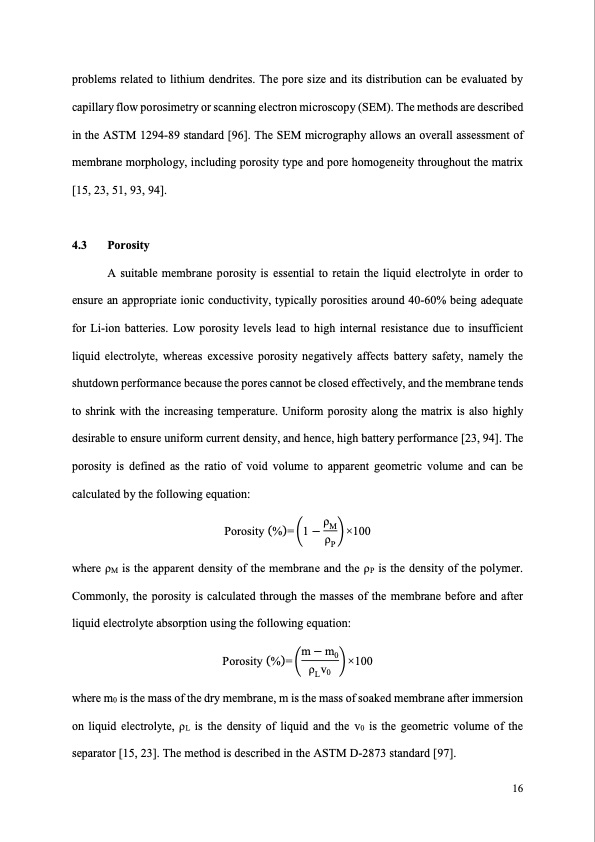
PDF Publication Title:
Text from PDF Page: 016
problems related to lithium dendrites. The pore size and its distribution can be evaluated by capillary flow porosimetry or scanning electron microscopy (SEM). The methods are described in the ASTM 1294-89 standard [96]. The SEM micrography allows an overall assessment of membrane morphology, including porosity type and pore homogeneity throughout the matrix [15, 23, 51, 93, 94]. 4.3 Porosity A suitable membrane porosity is essential to retain the liquid electrolyte in order to ensure an appropriate ionic conductivity, typically porosities around 40-60% being adequate for Li-ion batteries. Low porosity levels lead to high internal resistance due to insufficient liquid electrolyte, whereas excessive porosity negatively affects battery safety, namely the shutdown performance because the pores cannot be closed effectively, and the membrane tends to shrink with the increasing temperature. Uniform porosity along the matrix is also highly desirable to ensure uniform current density, and hence, high battery performance [23, 94]. The porosity is defined as the ratio of void volume to apparent geometric volume and can be calculated by the following equation: Porosity (%)= (1 − ρM) ×100 ρP where ρM is the apparent density of the membrane and the ρP is the density of the polymer. Commonly, the porosity is calculated through the masses of the membrane before and after liquid electrolyte absorption using the following equation: Porosity (%)= (m − m0) ×100 ρL v0 where m0 is the mass of the dry membrane, m is the mass of soaked membrane after immersion on liquid electrolyte, ρL is the density of liquid and the v0 is the geometric volume of the separator [15, 23]. The method is described in the ASTM D-2873 standard [97]. 16PDF Image | Synthetic Polymer-based Membrane for Lithium Ion

PDF Search Title:
Synthetic Polymer-based Membrane for Lithium IonOriginal File Name Searched:
C11.pdfDIY PDF Search: Google It | Yahoo | Bing
CO2 Organic Rankine Cycle Experimenter Platform The supercritical CO2 phase change system is both a heat pump and organic rankine cycle which can be used for those purposes and as a supercritical extractor for advanced subcritical and supercritical extraction technology. Uses include producing nanoparticles, precious metal CO2 extraction, lithium battery recycling, and other applications... More Info
Heat Pumps CO2 ORC Heat Pump System Platform More Info
| CONTACT TEL: 608-238-6001 Email: greg@infinityturbine.com | RSS | AMP |